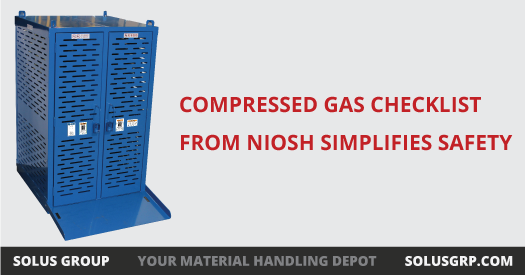We use cookies to make your experience better. To comply with the new e-Privacy directive, we need to ask for your consent to set the cookies. Learn more.
Compressed Gas Checklist from NIOSH Simplifies Safety
Compressed gas cylinders allow laboratories, industrial plants, and many other workplaces to accomplish a wide variety of tasks. While the utility of compressed gas is undeniable, almost all types of compressed gas pose a safety risk when mishandled.
The Dangers of Compressed Gas
Flammable gases, like ethylene, vinyl chloride, and acetylene can cause explosions or fires. Toxic gases, like ammonia, can poison the air. Even inert gases like helium can displace the air in a room and cause asphyxiation.
Then, there's the cylinder itself. A damaged cylinder can explode, sending shrapnel around a room. If a cylinder's valve breaks, the high-pressure air can turn the metal container into a missile. Even the simple event of a cylinder tipping over can break a worker's foot or hand.
The NIOSH Checklist
With all these dangers, there's good reason to be cautious with compressed gas. OSHA's General Industry standard 29 CFR 1910.101 issues regulations for handling compressed gas cyliners. However, those regulations refer employers to several pamphlets from the Compressed Gas Association. An easier way to comply with OSHA requirements is to use compressed gas self-inspection checklist created by NIOSH. 
The checklist contains 30 questions that help employers ensure that compressed gas cylinders are handled safely. Let's take a look at the most essential precautions.
Handling Compressed Gas
The number one task in transporting compressed gas is to keep the cylinder upright and immobile. Cylinder transporters should have bars or chains to keep cylinders from falling over or jostling more than necessary. As mentioned above, a fallen cylinder can seriously hurt an employee. And if the valve breaks off, the cylinder can be even more dangerous.
For smaller industrial cylinders, transport cages can provide the necessary stability and ventilation. Staff should never drag cylinders when moving them as this can cause damage that weakens the container.
Storing Compressed Gas
Cylinder storage cages should provide ample ventilation to prevent the accumulation of leaked gas. Storehouses should also keep cylinders off of the ground to prevent rusting.
Facilities should never store cylinders near highly flammable substances. In addition, staff should separate flammable gases and oxidizing gases. In many cases, using several smaller storage cages will allow for easier separation of gases.
Training and Inspection are Key
Many of NIOSH's checklist items ensure that cylinders are undamaged and in good, working order. Storing and transporting cylinders in a secure and stable way prevents unnecessary wear and tear. Still, all equipment has a finite lifespan, and managers should properly dispose of cylinders that are no longer suitable for use.
Staff and managers must collaborate to ensure the safe handling of compressed gas cylinders. NIOSH's safety checklist (along with proper transport and storage equipment) simplifies the process.
References:
"Compressed Gases Self-Inspection Checklist." CDC. The National Institute for Occupational Safety and Health, Centers for Disease Control and Prevention, Oct. 2003. Web. 8 Aug. 2017.
"29 CFR 1910.101 - Compressed gases (general requirements)." OSHA. Occupational Safety and Health Administration, United States Department of Labor, n.d. Web. 8 Aug. 2017.
"Compressed Gas Cylinder Hazards." Rochester. University of Rochester, n.d. PDF. 8 Aug. 2017.
